Climate change and Wales: Where we are in charts
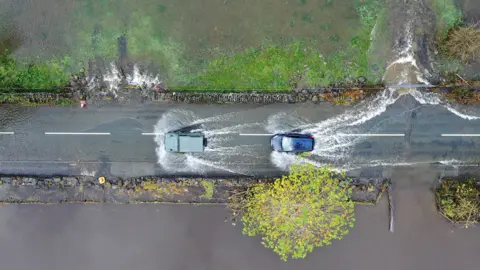 Getty Images
Getty ImagesThe UK is hosting a summit at the end of October which is regarded as crucial if climate change is to be brought under control.
The COP26 meeting in Glasgow could lead to major changes to our everyday lives.
Here we outline in charts some of the key facts about the state of Wales and its climate change challenges.
1. Cows and cars - what's behind the emissions in Wales?
It's not something to be sniffed at but the 8.9 million sheep and 414,000 cows in Wales add a peculiar facet to the climate change landscape in Wales.
Agriculture contributes nearly 14% of greenhouse gas emissions in Wales, with gases generated from the rear ends of livestock providing a good chunk of that.
Energy supply, particularly from power generation, is the biggest single source though.
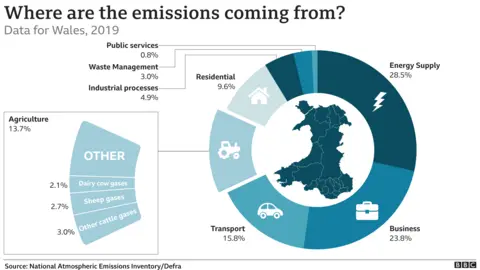

Cars alone are behind nearly 60% of transport's share, but there is hope the move to hybrid and electric vehicles may have an impact.
The iron and steel industry in Wales is the source of 60% of the business sector's emission levels in Wales.
2. Emissions generally falling but the big challenge is the next 30 years
It's been a bumpy road. As we can see from the chart below, there have been years recently when emissions have gone up, as well as down.
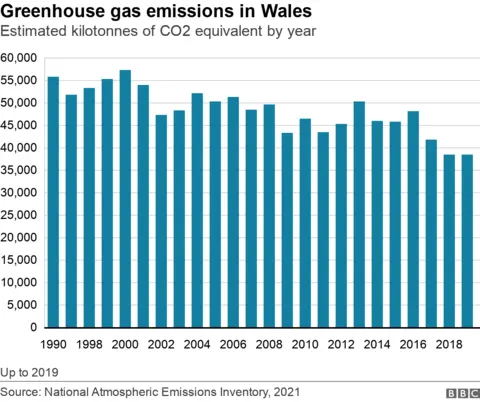

It's mainly because we've got lots of heavy industry and some massive power plants. Just shutting Wales' last coal-fired power station helped towards half of the fall in emissions after 2016.
Although overall we've seen a 31% cut in emissions over the last 30 years, by 2030 we need to have reached a 63% reduction - and in the 20 years after that, we have to have net zero carbon emissions. A big challenge.
3. Flooding risks set to increase on the coasts
About 60% of us in Wales live in coastal areas, with some communities living below the high tideline.
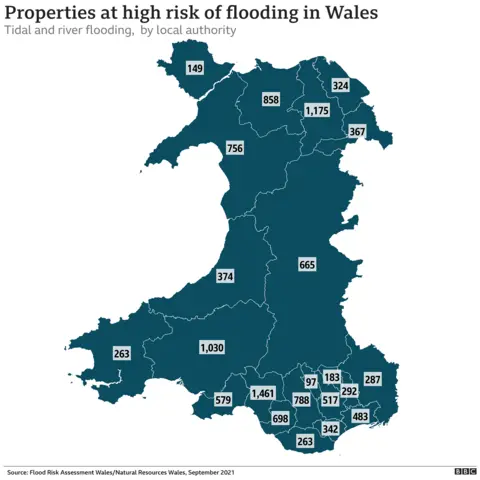

Just under 12,000 properties are at high risk from coastal or river flooding. There are just under 10,000 at high or medium risk of tidal flooding alone.
This could increase by 260% by the 2080s - while 2,126 properties are likely to be at risk of coastal erosion where defences are not maintained.
We've also got nationally important infrastructure - roads, railways, and big power plants - next to the sea.
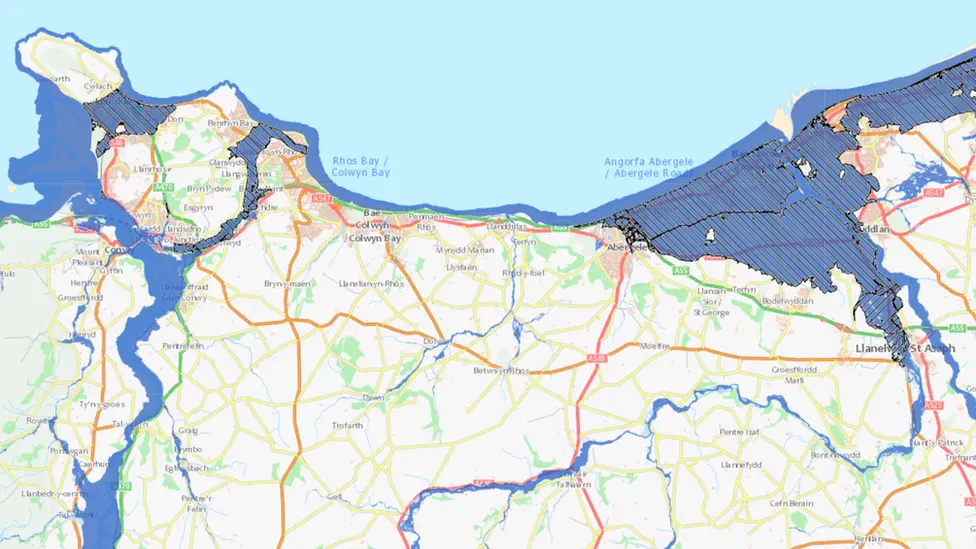 NRW
NRWFlooding risk from climate change has been built into new planning policy for developments in Wales, with details released in September
These included new flood risk maps, like the one shown above for the north Wales coast.
By 2050 it's thought it could get 6% more rainy in winter in Wales, with as much as 13% more rain by the 2080s. Also, when it does pour down it could be more intense, making flooding issues worse.

COP26 climate summit - The basics
- Climate change is one of the world's most pressing problems. Governments must promise more ambitious cuts in warming gases if we are to prevent greater global temperature rises.
- The summit in Glashow is where change could happen. You need to watch for the promises made by the world's biggest polluters, like the US and China, and whether poorer countries are getting the support they need.
- All our lives will change. Decisions made here could impact our jobs, how we heat our homes, what we eat and how we travel.

4. Air pollution - where are the pinch points?
Traffic fumes from petrol and diesel cars are part of the problem when it comes to warming the atmosphere. But they also contain harmful pollutants that we breathe in - like nitrogen dioxide (NO2).
The chart below shows NO2 as it is measured at 187 industrial and commercial sites around Wales.
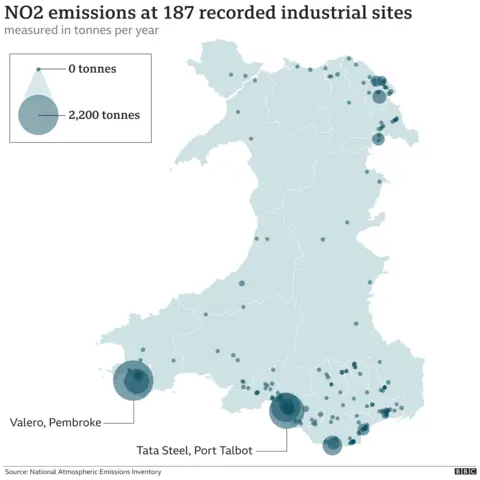

Refineries, iron and steel-making and cement works dominate the top 10 emission locations across the nation.
Heavy industry supports substantial numbers of jobs, so the challenge is how to make processes cleaner - and move towards a greener economy.
5: Are we travelling in a greener way?
One thing we all noticed during the Covid pandemic - the roads were a lot quieter. In fact, traffic on the roads in Wales dropped by nearly a quarter last year due to Covid and to levels we've not seen since 1998.
So really we need to look at what "normal" looks like.


Between 1993 and 2019, traffic volumes rose by 45%. A third of it was moving within Cardiff, Rhondda Cynon Taf, Carmarthenshire and Newport. We can also see in recent years that more of us were travelling by train too.
Moving towards more public transport - and active travel - are priorities for policy makers.
Latest surveys show 4% cycle to work or to a destination at least once a week, while 60% of us walked for an hour a week at least, for the same purpose.
Cycling was the one mode of transport which actually showed a rise during lockdown, as many people worked from home or travelled locally.
6. Wildlife and habitat already being lost
Climate change is already having an increasing impact on Wales' natural world, according to conservation groups.
The annual State of Nature report, published jointly by leading wildlife and nature charities, gives a snapshot of the threats in Wales.
The kittiwake population of Wales has declined by 35% since 1986. Across the UK, climate change has reduced the availability of sand eels, a key food source.
As well as seeing birds migrating here that we would not usually expect to see, swallows are arriving 15 days earlier and breeding 11 days earlier than they did in the 1960s
Areas threatened include salt marsh habitats.
We know 17% of species in 2019 were under threat of extinction.
7. Tree planting - hope for growth
Woodland in ancient times used to cover much of Wales. Today, it makes up only about 15% of the land mass, but there is an ambition to create a National Forest for Wales.


As well as protecting existing trees, the programme would see more woodland planted. New trees would eventually help climate change by taking carbon from the air as they grow, while also creating more habitat and helping to reduce flooding.
But there has been a fall-back in new planting of woodland in recent years, so there is some ground to make up.
8: Energy generation - how important are renewables in Wales?
In 2017, the Welsh government announced a target of meeting the equivalent of 70% of Wales' electricity demand from renewable electricity sources by 2030. In 2019, it is estimated that this figure stands at 51%.


When we look at estimated electricity generated in Wales, more than two thirds comes from gas. Renewables account for 27% - with more than 18% of that from wind energy.
The last coal-fired power station closed more than 18 months ago and there is currently no nuclear power option.
9: Recycling - what are we doing to help?
It's not all doom and gloom. Wales is one of the world's best nations for recycling, according to one analysis.
The research from the Eunomia environmental consultancy, at the end of 2017, looked at comparable data from each country to work out the kilograms per head recycled.


Latest Welsh government figures show 64.8% of waste was recycled or composted in 2020 - a slight increase on 2019, despite the pandemic.
Each of us still produces an average 173kg of household waste that's not recycled - but that has come down by 20% in seven years.


